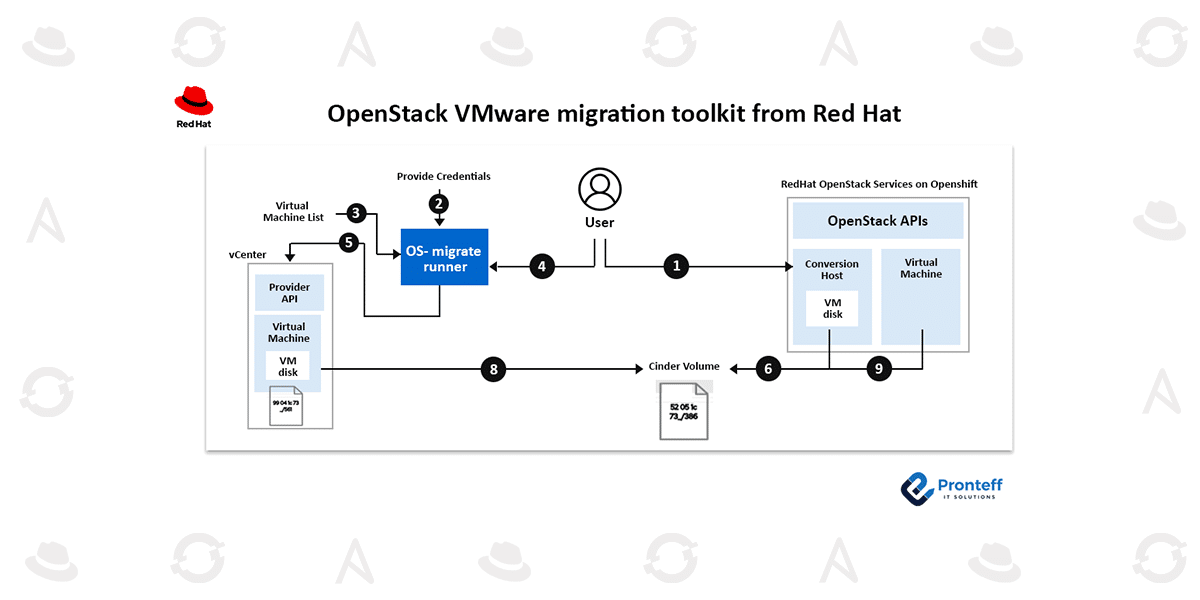Openstack VMware migration toolkit from Red Hat
In this blog, we are going to learn about the OpenStack VMware Migration Toolkit from Red Hat.
Last year, Red Hat unveiled Red Hat OpenStack Services on OpenShift, marking a major evolution of the Red Hat OpenStack Platform. This new architecture merges the robust Infrastructure-as-a-Service (IaaS) capabilities of OpenStack with the flexibility of Red Hat OpenShift, allowing enterprises to run virtualized and containerized workloads on a single, unified platform. As organizations continue to focus on cost optimization and IT consolidation amid changing market demands, Red Hat is introducing the Red Hat OpenStack VMware Migration Toolkit — built on the os-migrate VMware toolkit open source project — to help simplify and accelerate the move to OpenStack Services on OpenShift.
A streamlined path to OpenStack Services on OpenShift
The Red Hat OpenStack VMware Migration Toolkit is designed to make the migration of mission-critical workloads from VMware environments more efficient and less disruptive. It provides an automated, scalable solution that enables organizations to modernize their infrastructure without compromising performance or uptime.
With this toolkit, users can:
- Migrate workloads seamlessly: Automates the process of moving existing VMs to Red Hat OpenStack Services on OpenShift with minimal downtime.
- Integrate with automation workflows: Easily incorporate the migration process into existing Red Hat Ansible Automation Platform playbooks.
- Scale efficiently: Capable of handling large-scale migrations across multiple workloads in shorter timeframes.
- Unify operations: Consolidate legacy virtualized workloads and modern, cloud-native applications under a single management framework.
- Enable warm migrations: A specialized Ansible collection simplifies the process of transferring workloads from VMware environments using changed block tracking (CBT) for minimal service interruption.
Key capabilities of the migration toolkit
Delivered as an Ansible collection, the migration toolkit includes a comprehensive set of features that simplify the end-to-end migration process:
- Discovery mode: Automatically collects VM metadata, including definitions, storage configurations, and networking details from VMware vCenter.
- Network mapping: Maps source VMware networks to target OpenStack networks while preserving MAC addresses.
- Flavor mapping and creation: Matches or dynamically generates OpenStack flavors based on VMware hardware profiles.
- Support for complex configurations: Handles VMs with multiple disks and NICs to ensure complete and accurate migration.
- Broad OS compatibility: Works with a wide range of guest operating systems certified for Red Hat OpenStack Services on OpenShift and compatible with virt-v2v.
How the migration process works
Migration begins by setting up a conversion host, configuring credentials, and defining migration parameters. From there, users can run a migration playbook through Ansible Automation Platform. The toolkit then:
- Collects detailed metadata and disk configurations of the source VMs.
- Provisions a Cinder volume and attaches it to the conversion host.
- Creates a snapshot of the VM’s disks in the VMware environment.
- Uses changed block tracking (CBT) to efficiently transfer data — initially copying the full disk, and later syncing only modified blocks during incremental updates.
Once the transfer is complete, the VM is instantiated in OpenStack, attached to the Cinder volume, and launched within the Red Hat OpenStack Services on OpenShift environment — all with minimal downtime.
Warm migration using CBT
The toolkit’s warm migration feature leverages changed block tracking to minimize disruption during VM transitions. By syncing only altered disk blocks after the initial copy, it significantly reduces both network load and storage overhead, ensuring that workloads are migrated efficiently and with minimal impact on operations.
Partner-led migrations for enterprise-scale deployments
While the migration toolkit empowers organizations to manage their own migrations, Red Hat’s certified partners — including Trilio, Hystax, and Cloudbase — offer specialized expertise for complex or large-scale projects. These partners bring proven methodologies, in-depth technical knowledge, and hands-on experience with OpenStack Services on OpenShift to accelerate deployment and minimize risks.
Working with a certified partner can:
- Shorten project timelines through structured migration planning.
- Ensure compliance and cost control throughout the migration process.
- Enhance reliability through integrated backup, data protection, and disaster recovery solutions.
By combining Red Hat’s automation-driven migration toolkit with partner expertise, organizations gain a trusted pathway to modernize their IT infrastructure — seamlessly transitioning from VMware to Red Hat OpenStack Services on OpenShift while maintaining performance, security, and business continuity.








